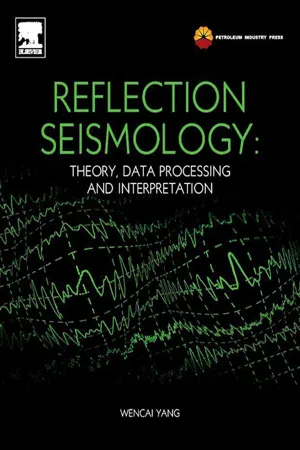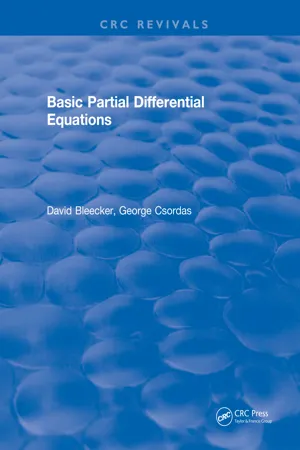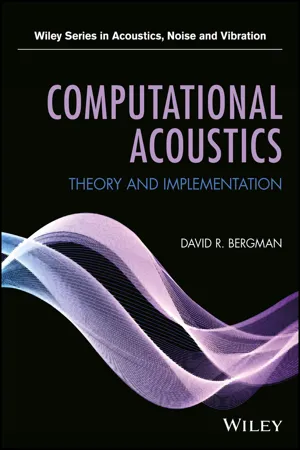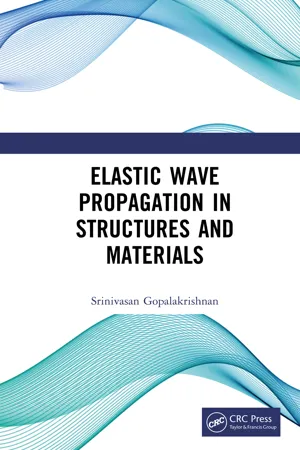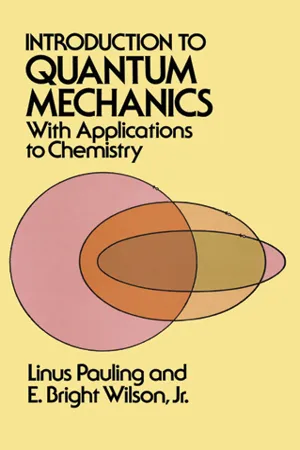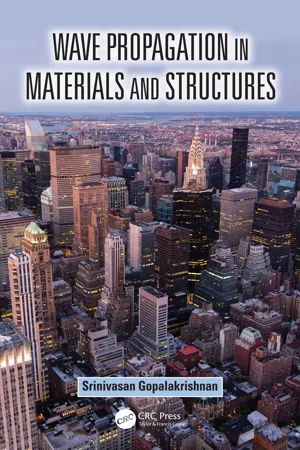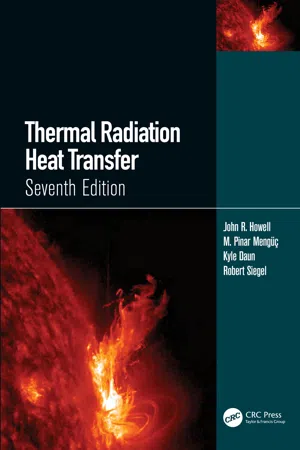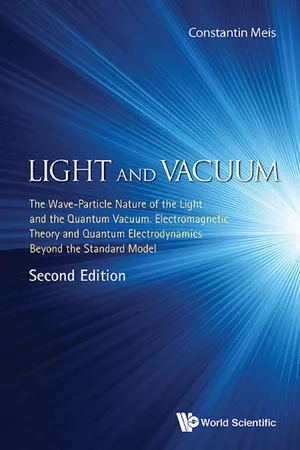Physics
Wave Equations
Wave equations are mathematical descriptions that represent the behavior of waves, such as light, sound, and water waves. They typically involve partial differential equations and describe how waves propagate through a medium. The solutions to wave equations provide information about the wave's amplitude, frequency, and wavelength.
Written by Perlego with AI-assistance
Related key terms
Related key terms
1 of 4
Related key terms
1 of 3
10 Key excerpts on "Wave Equations"
- eBook - ePub
Reflection Seismology
Theory, Data Processing and Interpretation
- Yang Wencai(Author)
- 2013(Publication Date)
- Elsevier(Publisher)
The motion of macroscopic objects in general can be divided into three types: The first is displacement, such as linear movement, rotation, flight, and flow. The second is vibration and wave motion, such as periodic motion, water wave, acoustic wave, and seismic wave. The third is chaotic movement, such as intermittent motion, turbulence, and nonlinear wave motion. This book only discusses classical vibration and wave theory. As a kind of physical movement, vibration can be described using an initial value problem of ordinary differential equations for a closed system, in which energy and information do not get exchanged between the system and the outside world. For an open system, in which energy and information get exchanged between the system and the outside world, the initial and boundary value problems of partial differential equations must be applied. This chapter discusses the basic wave theory, focusing on the acoustic wave equation and related wave behaviors.To make mathematical formulas clear, we use bold English letters for vectors or matrices, and normal Greek letters for scalars in this book.1.1 Wave Motion in Continuous Media
Wave motion refers to the propagation of vibration in continuous media, which can be described by using the following formulations:Wave motion = vibration + propagation (in continuous media); Vibration = periodic motion that an object moves around its equilibrium point; Propagation = interaction between the vibration and adjoining mass grains and diffusion of the vibration energy.The above concepts are limited to the situation that the vibration equilibrium point of mass grains is fixed and is stationary during wave propagation; they are accurate for the elastic waves propagating in solid media. Generalized waves involve situations in which the vibration equilibrium point is not fixed and movable. For example, water waves are a kind of generalized waves with moving equilibrium points. We do not discuss generalized waves in this book. - eBook - ePub
Partial Differential Equations
An Introduction to Theory and Applications
- Michael Shearer, Rachel Levy(Authors)
- 2015(Publication Date)
- Princeton University Press(Publisher)
CHAPTER FOURThe Wave EquationThe wave equationis the prototype for second-order hyperbolic PDE, modeling the propagation of sound waves; electromagnetic waves, such as light; and waves in elastic solids. We show in detail how the wave equation describes the deformation of one-dimensional elastic solids, specifically, thin rods and elastic strings.Central to the study of the one-dimensional equation is d’Alembert’s solution, an explicit formula for solutions of initial value problems. The method of spherical means provides a corresponding explicit formula in two and three dimensions. In three dimensions, this formula embodies Huygens’ principle of light propagation. From the wave equation we derive an energy principle in which the total energy (the sum of kinetic and potential energy) is conserved.4.1. The Wave Equation in ElasticityWe introduce the wave equation with a simple derivation from one-dimensional elasticity theory. The derivation illustrates the basic notions of conservation laws and constitutive equations introduced in Chapter 2 . Then we discuss a second application, to an elastic string vibrating in a plane. Conservation of momentum leads to a system of nonlinear PDE. Considering small-amplitude vibrations near a stationary string, we linearize the equations, thereby deriving two Wave Equations with different wave speeds. One equation represents longitudinal motion along the string, and the other represents transverse motion—the vibrations seen in a guitar or violin string.4.1.1. Longitudinal Motion of a Thin Elastic RodConsider a thin elastic rod undergoing only longitudinal deformation (extension or compression), with no bending.We label locations of cross sections in the rod by using points in a reference configuration, an interval, say 0 ≤ x ≤ 1. (See Fig. 4.1 .) The physical configuration is also an interval 0 ≤ u ≤ L, depending on the deformation. The cross section labeled x in the reference configuration has coordinate u(x, t) in the physical configuration at time t. It is convenient, but not essential, to think of the reference configuration as being the rod in equilibrium, with no forces acting on it. The function u is called the displacement; it is the unknown, or dependent variable. We assume the density ρ (mass per unit volume in the reference configuration) is constant, and that the cross-sectional area A - eBook - ePub
- Jean-Louis Guyader, Jean-Louis Guyader(Authors)
- 2013(Publication Date)
- Wiley-ISTE(Publisher)
Chapter 5Vibratory Phenomena Described by the Wave Equation
5.1. Introduction
The wave equation is a partial derivative equation which we highlighted in Chapter 3 during the study of longitudinal and torsion vibrations of beams. This equation is also representative of two other vibratory phenomena which are often encountered: vibrations of cords and fluctuations of acoustic pressure in pipes.The study of the wave equation is particularly interesting because its relative simplicity makes it possible to easily find a solution and describe many basic concepts.In the first section we present the problem, and more precisely we recapitulate the set of applications of the wave equation; then we demonstrate the uniqueness of the solution. In the following section, we provide a solution by the method of propagation, which will lead us to notion of the image source to take into account the boundary conditions. Resolution by separation of variables will then be carried out, which will lead to the key concept of the natural mode of vibration, from which will result the general form of the response by modal decomposition. Finally a summary table of the modal system for the case of standard boundary conditions is drawn up.The last section will give a detailed presentation of two applications with some of the most remarkable physical tendencies of vibratory behavior. Moreover, they will provide practical examples of calculations, modal system and vibratory response, with displacements as well as with stresses.5.2. Wave equation: presentation of the problem and uniqueness of the solution
5.2.1. The wave equation
The wave equation is the following partial derivative equation:[5.1]The function y(x, t) represents vibratory movement, the constant c is characteristic of the studied medium; it is called celerity or waves propagation velocity.This equation is representative of longitudinal vibratory and torsion movements of homogenous beams, as we have shown in Chapter 3 . In fact, vibrations of cords and fluctuations in pressure in pipes are also governed by this equation. The correspondence between the general equation [5.1] and the four physical situations that it describes is presented in Table 5.1 - eBook - ePub
- David. Bleecker(Author)
- 2018(Publication Date)
- Chapman and Hall/CRC(Publisher)
Chapter 5 The Wave Equation Physical scientists, engineers and applied mathematicians regard the wave equationin dimension 3, as one of the most important PDEs, because this equation describes the vibrations of continuous mechanical systems, and the propagation of electromagnetic and sound waves. We have discussed some applications of the wave equation in Section 1.2 of Chapter 1 . In this chapter, we will study a special case of (*), the one-dimensional wave equationwhen u does not depend on y and z (cf. Chapter 9 for a study of (*)). For definiteness, we interpret u(x,t) as the transverse displacement (in a direction perpendicular to the x—axis) of a vibrating string at position x, at time t. With this model in mind, in Section 5.1 , we use Newton’s second law to derive (**), and solve this equation when the initial profile and velocity of the string is specified by finite Fourier sine series. We also establish the uniqueness of solutions by proving that the energy is conserved. In Section 5.2 , we derive D’Alembert’s formula for the solution of initial value problems for the infinite string. The method of images is used with D’Alembert’s formula to solve several problems for the semi-infinite and finite strings, and to prove certain maximum principles which are needed to analyze the error of a solution due to an error in the initial conditions. We begin Section 5.3 with a discussion of the various standard types of B.C.. The same techniques which were used in Chapter 3 to solve heat problems with inhomogeneous B.C. are shown to also work for wave problems. Moreover, a version of Duhamel’s method is motivated and used to solve problems for the inhomogeneous wave equation which results when external forces act on the string.Historical Remarks - eBook - ePub
Computational Acoustics
Theory and Implementation
- David R. Bergman(Author)
- 2018(Publication Date)
- Wiley(Publisher)
3 Derivation of the Wave Equation3.1 Introduction
The linear wave equation can be derived from several different starting points depending on whether the vibrations are traveling in a solid or fluid. In the case of vibrations in a solid, the form of the wave equation will depend on the symmetries of the solid structure and material properties [1]. Since the subject matter of this text deals with methods for modeling wave propagation in fluids, this will be dealt with in detail. Derivations of acoustic vibrations in solids for various models are presented briefly in the interest of demonstrating the connection of the wave equation, and generalizations of the wave equation, to the equations of the supporting medium. Reviewing the connection between the medium and the wave equation will serve two purposes: one is to provide a tangible connection between two paradigms, a micro description of the system and the macroscopic phenomena supported by the system, and the other is to show a direct connection between material properties, such as density, bulk modulus, and so on, and the observed properties of the wave as a separate entity, e.g. velocity.Sections appear as follows. The first section describes wave phenomenon without any reference to the medium. This is to establish basic vocabulary. The next section is a review of the coupled mass–spring system from classical mechanics along with a description of normal modes of vibration. The limit to a continuum is taken to arrive at an equation for wave propagation in one spatial dimension. Following the treatment of one‐dimensional waves is a presentation of the equations for wave propagation in three‐dimensional elastic solids. This presentation starts with the stress–strain relation, Hook’s law, and continuum mechanics and passes to a second‐order wave equation. The next section presents a detailed derivation of the linear first‐ and second‐order Wave Equations derived from the equations of fluid mechanics. This will be the foundation for the discussion of modeling methods for describing the acoustic field. This section introduces a novel way of looking at the differential operator in the wave equation, appearing in the acoustics literature in the late 1970s, which uses concepts from differential geometry and tensor analysis. Following waves in fluids is a very brief section on thin plates and rods, followed by a description of phonons from solid‐state physics. After a survey of the various manifestations of the wave equation, this chapter concludes with a brief section on tensors and manifolds to serve as preparation for later chapters. - Srinivasan Gopalakrishnan(Author)
- 2022(Publication Date)
- CRC Press(Publisher)
Dispersion Relations, which is a plot of wave velocity with the frequency. These relations reveal the characteristics of different waves that are generated in a given material system.3.1CONCEPT OF WAVENUMBER, GROUP SPEEDS AND PHASE SPEEDS
A wave propagating in a medium can be represented asu ( x , t ) =(3.1)ei ( k x − ω t )Eqn. (3.1) is an alternate way of representing wave, which is given in Chapter 1 (Eqn. (1.1)). In the above equation k is the wavenumber, which specifies the behavior of the wave. The exponent in Eqn. (3.1)i ( k x − ω t )is called the phase of the wave. If the wave moves with constant phase, then we have(3.2)= 0 , ord ( i ( k x − ω t )d t=d xd tC p=ω kIn the above equation, Cprepresents the speed of the wave that moves with constant phase and hence it is called Phase speed. From the point of view of sending information, these waves are not useful. They are the same throughout the time and the space. Some quantities must therefore be modulated, such as frequency or amplitude, in order to convey information. The resulting wave may be a perturbation that acts over a short distance, which is called a wave packet- Linus Pauling, E. Bright Wilson, E. Bright Wilson(Authors)
- 2012(Publication Date)
- Dover Publications(Publisher)
The problem of the normalization of wave functions of this type, the value of which remains appreciable over an infinite volume of configuration space (corresponding to a continuous spectrum of energy values), is a complicated one. Inasmuch as we shall concentrate our attention on problems of atomic and molecular structure, with little mention of collision problems and other problems involving free particles, we shall not discuss the question further, contenting ourselves with reference to treatments in other books. 1 In discussing the physical interpretation of the wave functions for this system, let us first consider that the physical situation is represented by a wave function as given in Equation 13–11 with W y and W z equal to zero and W x equal to W. The function 1 is then a set of standing waves with wave fronts normal to the x axis. The wave length is seen to be given by the equation In classical mechanics the speed v of a free particle of mass m moving with total energy W is given by the equation 1/2 mv 2 = W. A further discussion of this system shows that a similar interpretation of W holds in the quantum mechanics. Introducing v in place of W in Equation 13–12, we obtain This is the de Broglie expression 2 for the wave length associated with a particle of mass m moving with speed v. It is the sinusoidal nature of the wave functions for the free particle and the similar nature of the wave functions for other systems which has caused the name wave mechanics to be applied to the theory of mechanics which forms the subject of this book. This sinusoidal character of wave functions gives rise to experimental phenomena which are closely similar to those associated in macroscopic fields with wave motions- eBook - ePub
- Srinivasan Gopalakrishnan(Author)
- 2016(Publication Date)
- CRC Press(Publisher)
Chapter 4 . The most common integral transform used for transformation of variables to the frequency domain is the FFT, although more recently the wavelet transform and Laplace transform are also becoming popular. All of these transforms have a discrete representation and hence these are amenable to numerical implementation, which makes their use very attractive for wave propagation analysis. By transforming the problem into the frequency domain, the complexity of the governing partial differential equation is reduced by removing the time variable from the formulation, thus making the solution of the resulting ODE (in the 1D case) much simpler than the original PDE. In wave propagation problems, two parameters are very important, namely, the wavenumber and the speeds of the propagation. This chapter provides a general methodology to compute these quantities for a material system. There are many types of waves that can be generated in structure. Wavenumber expression reveals the type of waves that are generated. Hence, in wave propagation problems, two relations are very important, namely, spectrum relations, which is a plot of the wavenumber with the frequency, and dispersion relations, which is a plot of wave velocity with the frequency. These relations reveal the characteristics of different waves that are generated in a given material system.This chapter is organized as follows. First, the concept of phase and group speeds and their behavior in different mediums are explained. The expressions for evaluating them are derived. Next, some of the commonly used wave propagation terminologies are explained. This is followed by a subsection, wherein the spectral analysis of motion is explained for a general one-dimensional second-order material system. If the governing equation of the material system is derived using higher-order theories, computation of wavenumbers becomes extremely difficult. In such situations, we need to obtain them numerically. In the last part of this chapter, this issue is addressed, wherein general methods of numerically computing wavenumbers and their corresponding wave amplitudes is given.
A wave propagating in a medium can be represented as5.1 CONCEPT OF WAVENUMBER, GROUP SPEEDS, AND PHASE SPEEDSu ( x , t ) =e.i ( k x − ω t )( 5.1 )Eqn. (5.1) is an alternate way of representing a wave, which is given in Chapter 1 (Eqn. (1.1) . In the above equation, k is the wavenumber, which specifies the behavior of the wave. The exponent in Eqn. (5.1) i(kx – ωt - eBook - ePub
- John R. Howell, M. Pinar Mengüc, Kyle Daun, Robert Siegel(Authors)
- 2020(Publication Date)
- CRC Press(Publisher)
Even though later studies have shown that quantum mechanics is a more general theory for energy transfer at all scales, EM wave theory is sufficient for understanding light and radiative energy propagation and its interaction with matter at most size ranges. The Maxwell equations can explain almost all fundamental physics, from nanoscales to stellar systems (Jackson 1998, Mishchenko et al. 2006). In the context of radiative transfer, the concepts of reflection, refraction, transmission, and scattering can be explained using these equations. In addition, values for these parameters, as well as absorptivity of materials can, in certain cases, be calculated from their optical and electrical properties, as shown for the applications in Chapter 3. However, the Maxwell equations do not account for blackbody emission, which needs to be considered separately and is discussed in Chapter 16. Here, relations between radiative, optical, and electrical properties are developed by considering wave propagation in a medium and the interaction between the EM wave and matter. An ideal interaction is considered for optically smooth, clean surfaces that reflect, refract, and transmit the incoming wave in a specular, i.e. mirror-like, behavior. Most real surfaces are not mirrorlike since almost all have surface roughness, contamination, impurities, and crystal-structure imperfections, requiring the development of different approximations to account for diffuse or diffuse-specular reflection, refraction, and transmission characteristics. The departures of real materials from the ideal conditions assumed in the theory can produce large variations of measured property values from theoretical predictions. Although the Maxwell equations cannot completely predict the radiative properties of real surfaces, they serve a number of useful purposes - eBook - ePub
Light And Vacuum: The Wave-particle Nature Of The Light And The Quantum Vacuum. Electromagnetic Theory And Quantum Electrodynamics Beyond The Standard Model (Second Edition)
The Wave–Particle Nature of the Light and the Quantum Vacuum. Electromagnetic Theory and Quantum Electrodynamics Beyond the Standard Model
- Constantin Meis(Author)
- 2017(Publication Date)
- WSPC(Publisher)
c, results directly from the intrinsic properties of the vacuum itselfAlthough the origin of the vacuum’s electromagnetic properties remains unknown, the last ones dictate the value of the highest possible velocity in the universe, c, in the frame of course of the present state of knowledge.The dispersion relation writes nowexpressing a fundamental relationship between the wave vector k and the angular frequency ω through the speed of the light c/n in a medium with refractive index n, where n = 1 for the vacuum.•Propagation equations of electromagnetic wavesTaking the curl of equation (3.1.14 ) and using (3.1.15 )Considering the classical vector formalismSo (3.2.18 ) writeswhich is the propagation equation for the electric field in a medium with refractive index nAn analogue equation can be obtained for the magnetic field flux intensity .•Helmholtz equationThe vector relations of (3.2.6 ) to (3.2.9 ) show that , and are perpendicular to each other and construct a right-hand coordinate system. Hence, the harmonic solutions of the propagation equation for the electric field and magnetic field induction writewith c.c. denoting the complex conjugate part.From (3.2.12 ), (3.2.17 ), (3.2.21 ) and (3.2.22 ), we deduce the Helmholtz equation for each component of the electric fieldIn other words, in the classical electromagnetic theory, the electric and magnetic fields oscillate perpendicularly along the propagation axis k with an angular frequency ω at the speed c/n.This is called simply a plane wave solution. In this representation the wave vector in vacuum (n
Index pages curate the most relevant extracts from our library of academic textbooks. They’ve been created using an in-house natural language model (NLM), each adding context and meaning to key research topics.
Explore more topic indexes
Explore more topic indexes
1 of 6
Explore more topic indexes
1 of 4
